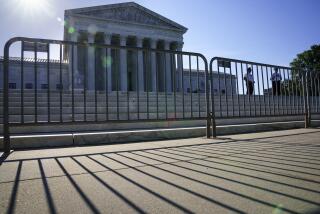Book review: ‘The Conservative Assault on the Constitution’ by Erwin Chemerinsky

- Share via
Southern Californians with a taste for politics or public policy probably know Erwin Chemerinsky best as the reliably liberal voice in countless left-right radio and television debates about timely legal questions or as a key contributor to Los Angeles charter reform efforts. Far fewer will be familiar with his day job as an influential legal scholar — author of a widely used textbook on the Constitution and professor of that subject at USC, Duke and, most recently, UC Irvine’s School of Law, where he is also founding dean.
“The Conservative Assault on the Constitution” is his urgent, admirably lucid amalgam of both those roles, along with Chemerinsky’s first-hand experience as an advocate arguing before the U.S. Supreme Court and a wide variety of lower appellate panels. He introduces his argument, in fact, with a nicely detailed anecdotal account of his appearance before the U.S. Supreme Court on behalf of Leandro Andrade, a man sentenced to life in prison under California’s draconian three strikes statute for shoplifting videotapes worth $153. Despite Chemerinsky’s advocacy, a court divided 5 to 4 upheld Andrade’s conviction, making him the first man in U.S. history imprisoned for life for petty theft.
By the author’s reckoning, the process that produced the florid injustice of Lockyer vs. Andrade began in 1968, when Richard Nixon made criticism of the Warren Court a centerpiece of the successful presidential campaign that ultimately enabled him to name four Supreme Court justices. “Since 1968,” Chemerinsky writes, “conservatives have sought to remake constitutional law and they largely have succeeded. They initially set out to overturn the decisions of the Warren Court, but soon began to aggressively pursue a vision of constitutional law that consistently favors government power over individual rights … and the interests of businesses over individual employees and consumers. Because decisions come one at a time over years and because the Court never overruled the Roe v. Wade abortion decision (though it came within one vote of doing so), it is easy to underestimate how successful the conservative assault on the Constitution has been.”
With that thesis as a starting point, Chemerinsky briskly moves from topic to topic in a clear but lawyerly fashion, building the evidence for his argument. Thus, there are chapters on the court’s role in resegregating so many of the nation’s schools, on the dramatic expansion of presidential powers, on the ongoing erosion of criminal defendants’ rights, on denial of due process and the general diminution of individual liberties. Many of these chapters are enlivened by journalistic accounts of the author’s first-hand experience participating in such consequential cases as Bush vs. Gore and the Texas Ten Commandments suit. Chemerinsky has a born teacher’s gift for evoking context, which he does with particular effect when he explores the interplay of electoral politics and the contention over separation of church and state.
The author strongly indicts the court’s conservative majority for its decision in Bush vs. Gore because he believes the justices were wrong on the law — and not for their activism. To the contrary, Chemerinsky believes that our political conversation’s false choice between judicial activism and neutral or “strict construction” judging has obscured the Supreme Court’s authoritarian drift. The Constitution, he argues, requires interpretation — and has since the earliest days of the Republic, when the Framers still were engaged in national government — and interpretation is inherently an active process.
“The difference between liberals and conservatives,” he writes, “is not in their willingness to overrule precedent or in their degree of deference to popularly elected officials or to make momentous decisions affecting society. The divergence is entirely about when they want the court to do this and for what purpose. The other difference is in their rhetoric; conservatives continue to rail against judicial activism and profess judicial restraint even though they are every bit as willing to be activist as liberals.”
Chemerinsky argues that another of the fictions that needs to be dispelled involves the confirmation process for Supreme Court justices and the notion that it’s somehow illicit to inquire into the nominees’ ideological inclinations or views on Constitutional interpretation. It’s not only a pious, rather convenient dodge, but a recently minted one. George Washington, for example, had a nominee for chief justice rejected on ideological grounds, and the practice was common throughout the 19th century and well into the 20th. The author points out that both conservative and liberal nominees recently have been all too willing to take refuge behind the prim new standard.
In place of what Vice President Joe Biden has labeled legislative kabuki, Chemerinsky argues for vigorous questioning of nominees regarding their ideological views and approach to constitutional interpretation. Although it’s clearly undesirable to have senators ask nominees how they might rule on pending cases, the author endorses what he calls the “elegant” suggestion by two Yale law professors that prospective justices be asked how they would have voted on previous cases and why. Such an approach wouldn’t divorce the court from politics — nor Chemerinsky would argue could it — but it would inject a welcome note of honesty and roll back the clouds of pious obfuscation that surround so much of what the court majority really is about.
To conclude his argument over why the conservative assault on the Constitution matters as deeply as it does, Chemerinsky talks about how the first assignment he gives his constitutional law students is to read the U.S. Constitution alongside the one adopted by the Soviet Union under Stalin. “My students,” he writes, “are always surprised to see that the Soviet constitution has a far more elaborate statement of rights than the American Constitution. I also assign them to read a description of life in the gulags. I ask how can it be that a country with such detailed statements of rights in its constitution could have such horrible abuses.
“The answer is that in the Soviet Union no court had the power to strike down any government action. Judicial review … is at the core of enforcing the Constitution and ensuring our freedom.”
In an election cycle awash in fictional, delusional and genuinely demented notions about the Constitution, Chemerinsky’s book is a welcome dose of real history, clear thought and genuine respect for the rule of law as a humane covenant.
timothy.rutten@latimes.com
More to Read
The biggest entertainment stories
Get our big stories about Hollywood, film, television, music, arts, culture and more right in your inbox as soon as they publish.
You may occasionally receive promotional content from the Los Angeles Times.










